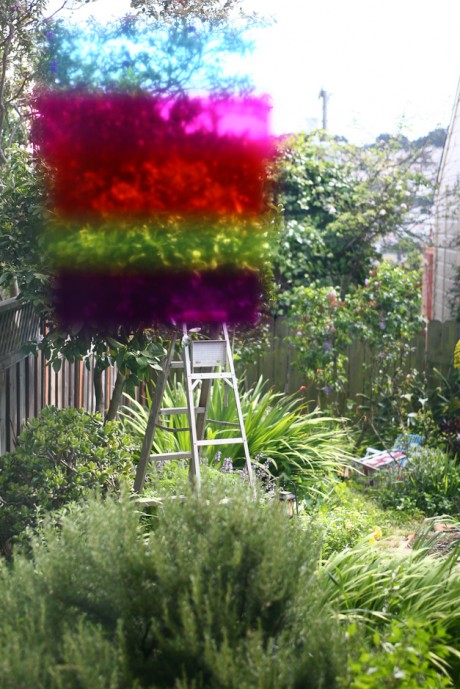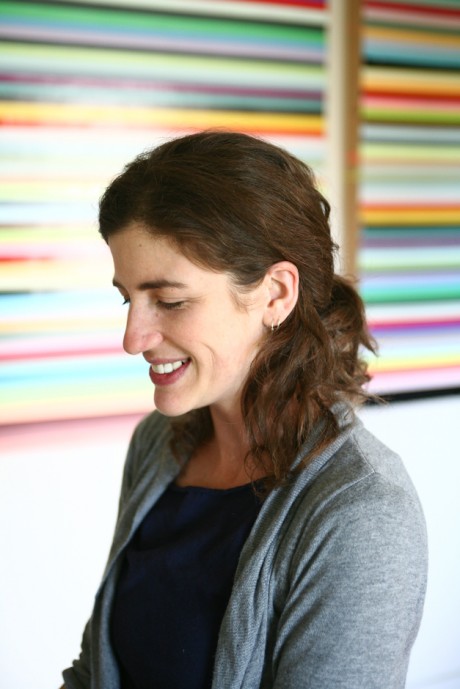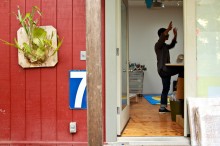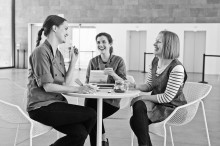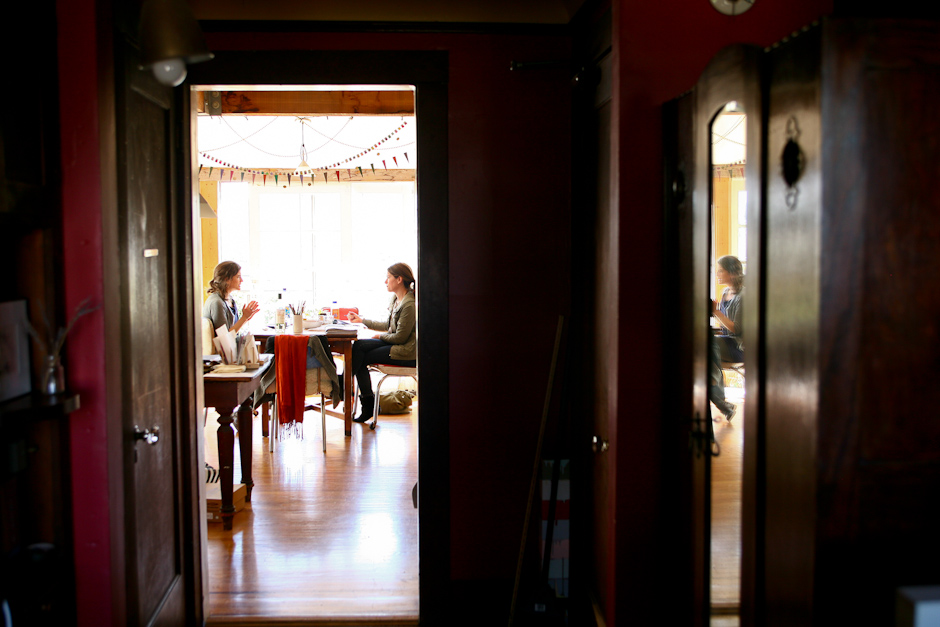
Leah Rosenberg
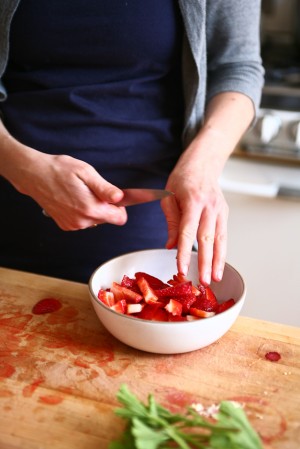

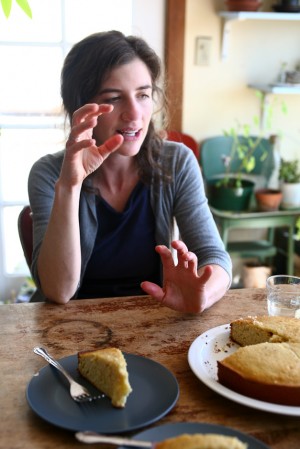
When Klea and I arrived at Leah’s home on the far side of Bernal Hill, she enthusiastically greeted us at the door and immediately brought us into her kitchen. As a painter and pastry chef, Leah takes an integrated approach to her work, often bringing both endeavors together to explore notions of generosity and gift giving. Leah’s hospitality is abundant— she had made geranium leaf infused lemon yogurt cake specifically for our visit and busily moved about the huge wooden work table in the middle of the kitchen. Off to the side, near the windows that look out onto the garden, we sat at a smaller table and I watched her coax the cakes out of the pans— her hands steady and skilled. After tasty pieces of cake and white wine spritzers, we went downstairs to the converted garage, which is now her painting studio. There were sculptural works made up of layers upon layers of different colored paint, and mason jars full of “confetti”, which is actually dried paint that Leah has methodically hole-punched into beautifully bright, perfect circles. She let us go through her flat file cabinet to check out paintings and pulled things out for us to get better looks. Leah works with lots of materials, and I ran my fingers across hardened paint, canvas, wood, and paper, wanting to touch everything, to feel the different surfaces, the changes in texture. Leah also showed us her room, just a few steps away from her painting studio. A stack of hand painted cards and paintbrushes were on her desk, and some of her paintings were up on the walls. Each part of the house that Leah invited us into seemed to be a place where she worked, where she brought things into being, where art, in some kind of form, was made.
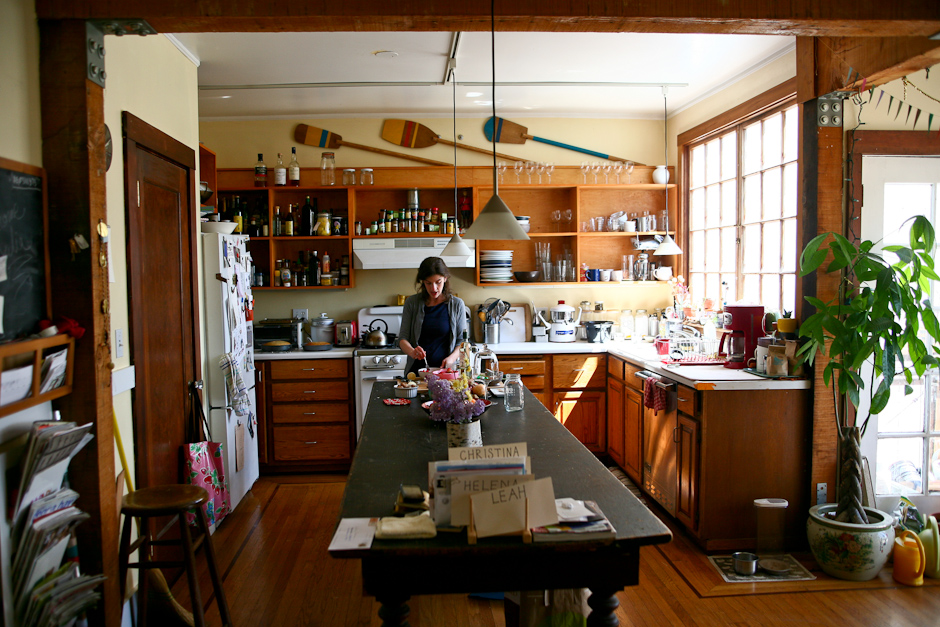

When people ask you what you “do”, how do you answer?
I am an artist and pastry chef. Or I work as a pastry chef and then I am also an artist. And I’m from Saskatoon!
Do you have a day job? What is it? What does it mean to you?
I work for Blue Bottle Coffee Company. They have a coffee bar on the rooftop sculpture garden at SFMOMA and I am a pastry chef there. All the pastries reference artworks either in the museum’s permanent collection or are based on a piece that’s in a current museum exhibition. It’s full time and creates structure for me. I also get to work at SFMOMA, which is kind of a dream as you can imagine.
I am not a formally trained pastry chef, so I am always learning. If a piece stands out to us in a show and looks like it should incorporate Turkish delight or marshmallows but I’ve never made those items or knew I could, there is research and development involved in figuring out how to do that. So it reflects what I would like my studio practice to incorporate-— an aspect of always learning and being a bit freaked out that I am trying to do something I’ve never done before and then, over time, getting used to doing it. And once you are comfortable with it, maybe it’s time to incorporate something new and unknown.
There are things at work that need to be done on a daily basis— like baking cakes, assembling and decorating them, which end up being my favorite things to do. When you do something everyday, you inevitably get better at it, and it becomes meditative. I’ve been thinking about that in terms of what I make in the studio, about what it would be like to make something everyday and perfect it. But I believe, in the studio, unlike the kitchen, that’s not the goal. In order to make interesting artwork, the point for me is to be not so sure of things. I’ve learned to embrace a kind of failure and try again.

What mediums do you work with? How would you describe your subject matter? What themes seem to occur/reoccur in your work?
Materials I like: paint, wood, ceramics. I would describe my subject material as process based. Stripes reoccur. Color. Cake or something edible most often accompanies a show I put together— it cultivates another layer of conversation and is an offering, something for the viewer to take away. I am interested in philosophies around generosity and gift giving, perhaps because of the inherent impossibility of generosity and the failures that prevail in attempts to make artwork with the intention of generosity.
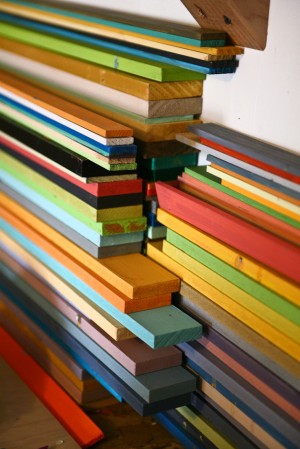
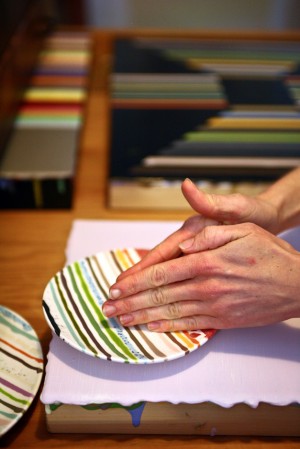

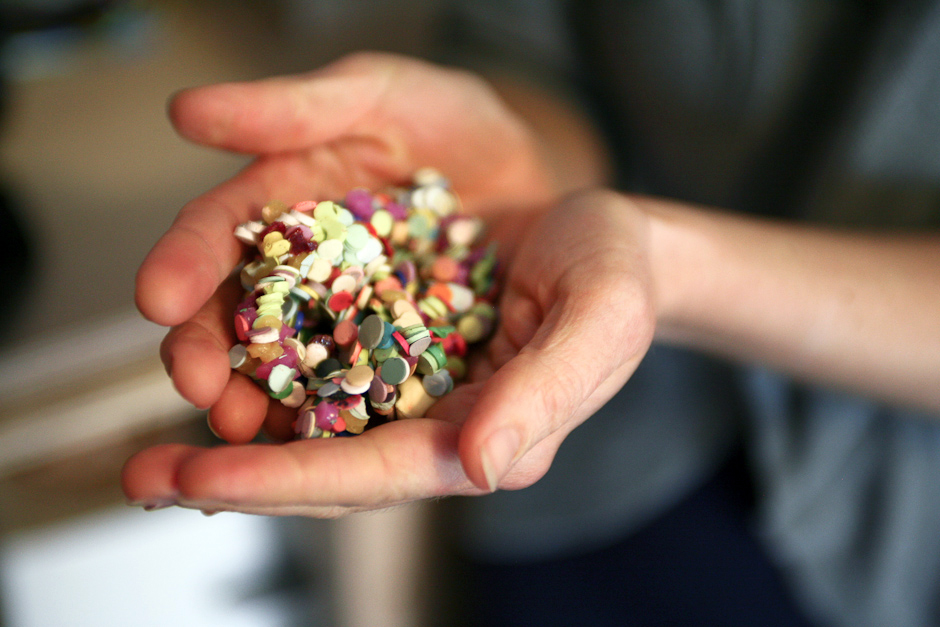
Has there been a shift or change in your life or work that has led to what you’re making now? Do you see your work as autobiographical at all?
I went to grad school as a fresh start, unlike some who know exactly what they are doing. I was looking at painters like Lari Pittman and trying to figure out how he made them. He created this space with overlapping shapes and viscosities, and they were funny to me. They told a story. I liked them and hated them. I was trying to make them and had every material known to Michael’s the craft store. I started taking cake decorating classes outside of school that first year because I was determined to get good at something. If it wasn’t paintings, then maybe cakes. I ended up with the cakes that I had completed at the end of the class and I would bring them to my critiques. I loved the response. It was the response I wanted when someone looked at one of my paintings hanging on the wall. As I continued to bring cakes to class, I paid attention to the response. I started to think about what cake does and if painting can do that— can a painting be generous? I was also thinking a lot about the different aspects of consumption involved with cake and painting. With cake there is an end— it gets eaten or it rots. There is no end to a painting. It hangs on the wall for constant judgment.
I suppose in a way, what I make now, coincides with my conception of existence— that we are made up of concretions and layers of experiences: sorrows, joys, pains, loves, fears, hopes. All of these come together in my work, in a record of personal experience that is intended for all to share even though much of it remains hidden, sealed within the process of its own making. I apply incremental layers of paint as part of my daily routine: as I go to or return from work, or in the moments between making dinner and eating it, or before going to bed. I used to have a process of selecting colors based on personal systems, sometimes referring to the text of a book that I am reading or the lyrics of a song, reflecting shared meals, or bits of conversations overheard. Now, the process of selecting colors has become more of a personal exercise that relies on intuition, rather than referencing anything in particular. The stripes and the layers in my work are a kind of calendar: a registration of time and effort, an index of days and experience, rather than a full-blown autobiography.

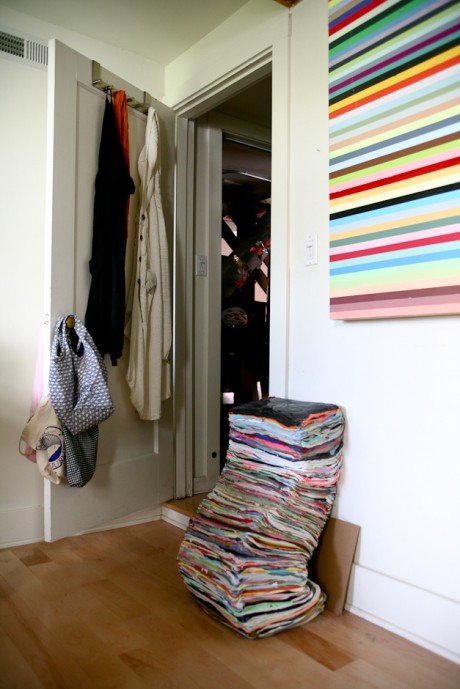

Is there something you are currently working on, or are excited about starting that you can tell us about?
Tall sculptures. Napkin folding— utilizing the forms that come with changing shapes. I am also making a cake for the upcoming SOEX art auction that I’m excited about.
What are your biggest challenges to creating art and how do you deal with them? How do you navigate the art world?
Time and confidence. The art world can get so competitive, so I try to remember that there is room for everyone. I stay working, and let people know that I’m working on stuff.
What are you most proud of?
Tough question. I guess I am proud when I accomplish something. When I realize I am making something that I have been thinking about for a while and I then find a way to put it out in the world.
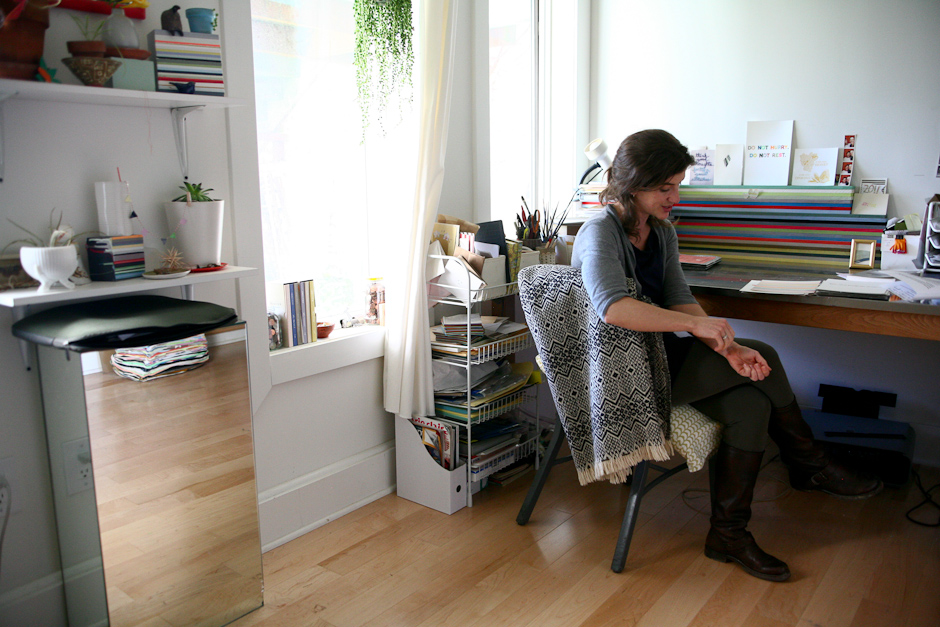
What advice has influenced you?
When I was young, my cousin taught me how to play pool. I was bad at physics and he was too, but he was trying to explain the bank shot through vectors and stuff. I got a bit frustrated and he said, “Really, you’ll do great it you just hit hard and hope for the best”. I think about that when I do things that feel unknown. Hit hard and hope for the best. And then there is a lot of advice given that I don’t listen to that has gotten me to here and now.
What do you want your work to do?
To engage people. Make them happy. For it to continuously feed them in a way, I guess. And that I learn something new in the process of me making it.
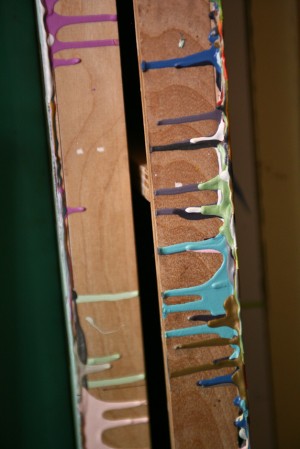
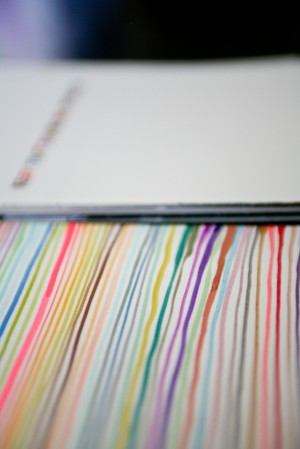

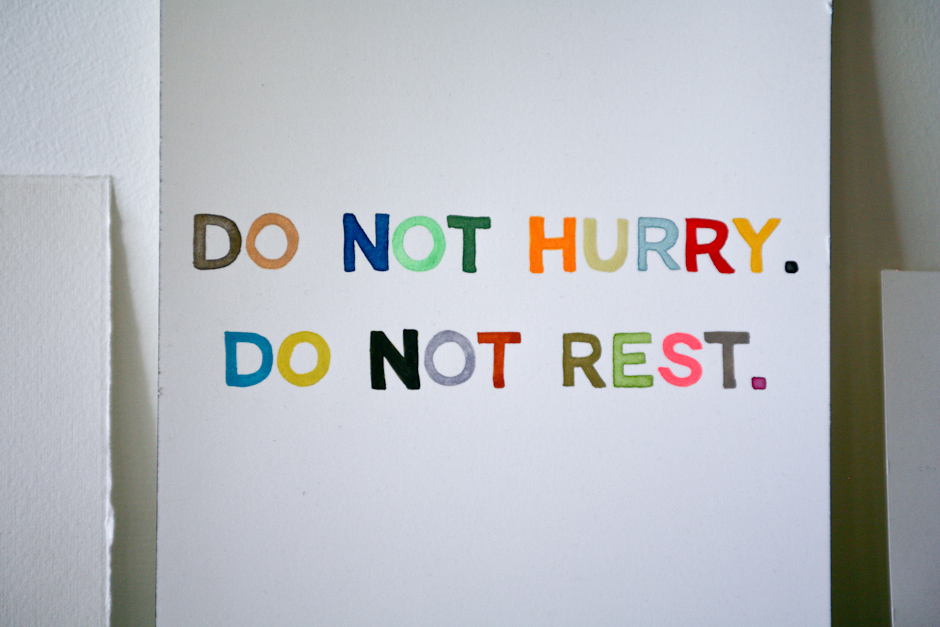
How will you know when you have arrived?
When you are actually able to make stuff and you have some money and materials and you are having some shows with interesting people and maybe someone notices. Isn’t that what we want to be doing?
To see more of Leah’s work:
www.leahrosenberg.com
